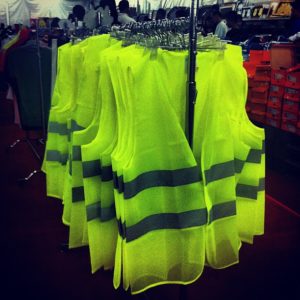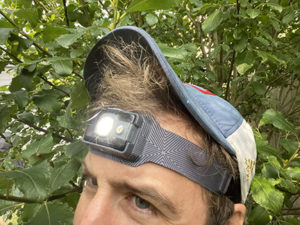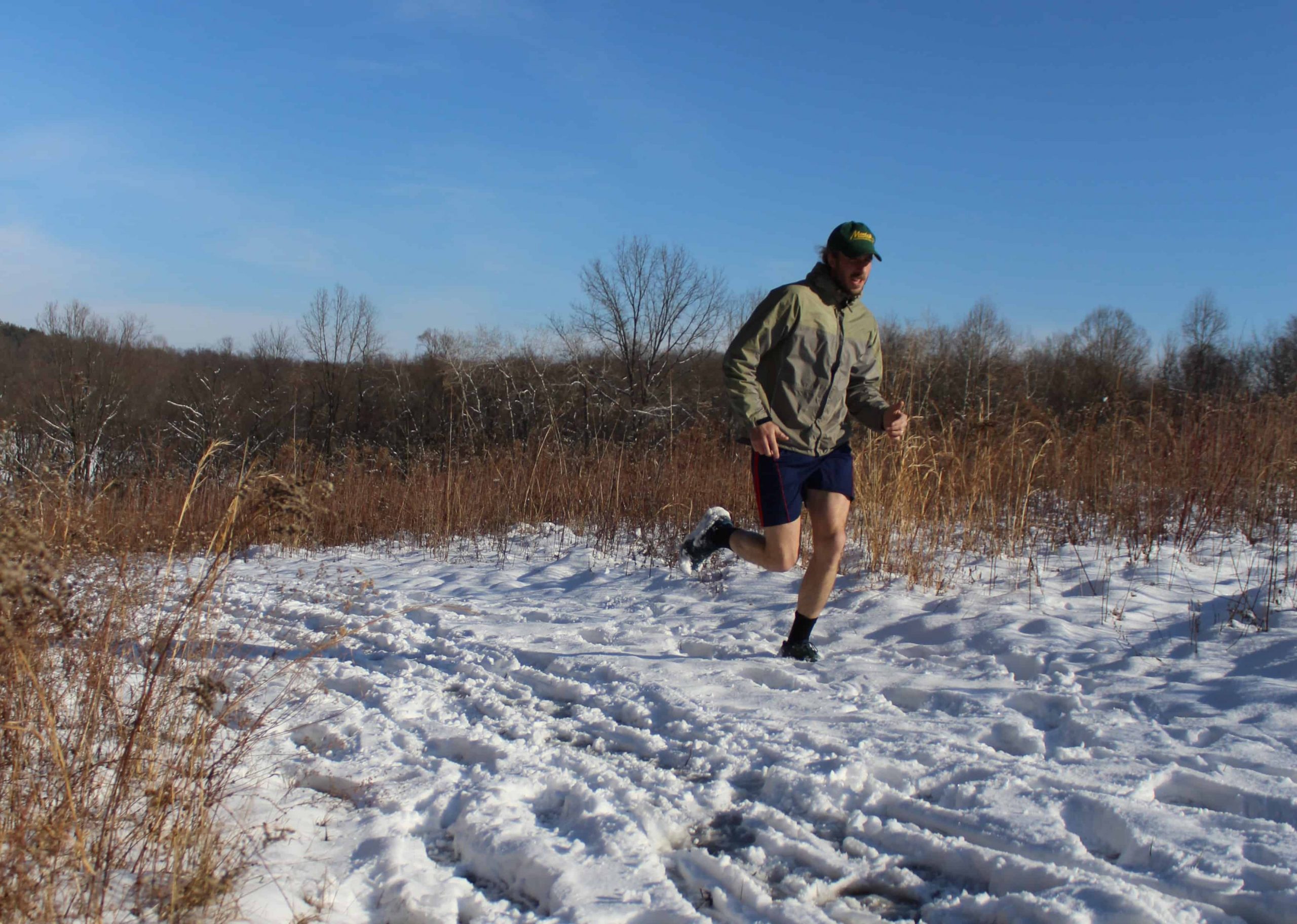Last updated on April 14th, 2021 at 05:29 pm
We all see those crazy people running on the coldest mornings. If you see these addicts and begin to wonder how they continually run outside in the coldest and most slippery conditions (without killing themselves in the process) you are not alone. In this post, we cover the most important winter trail running safety tips.
When you’re running on trails in the winter you should focus on a few very simple techniques to stay safe. Here are the 8 safety tips for winter trail running:
- Ease into Winter Trail Running
- Wear Bright Clothing
- Wear Reflective Gear
- Buy a Headlamp
- Take a Phone or GPS Watch
- Use Foot Traction on Ice
- Dress in Warm Clothes
- Run with Friends
We go into much more detail further on in this post, so if you want to get more information on how to successfully run trails all winter long, keep reading.
Winter Trail Running Disclaimer
While hitting the trails in the winter can be awesome it should be stated that trail running in the winter can also be dangerous. Safety needs to be prioritized.
Simply put, bad stuff can happen, and when it happens in subfreezing temperatures the outcomes are usually worse for everyone involved. So, special attention needs to be given to safety when thinking of hitting the icy trails.
Challenges of Winter Running
Winter running safety is a bit more specified than general running for three main reasons:
- It’s Darker Outside: The sun is further from us in the winter months. Because of this, there are fewer hours of sunlight each day. We can’t let that stop us though, which is why battling winter darkness is a big part of winter running safety.
- It’s Cold Outside: Temperature is an obvious consequence of winter. If you want to do things outside you have to be ready to deal with the cold.
- It’s Slippery: Because of the temperature fluctuations in winter, the running surfaces are more unpredictable. We have to be ready to take these on.
If you can find a way to deal with the dark, the cold, and the slippery conditions you will likely have a great winter trail run. Now, let’s explore in more detail how to safely handle these challenges.
1. Ease into Winter Trail Running
Our recommendation would be to delve into the winter running world by taking a shorter run to see how your layering efforts felt comfort and warmth wise.
Maybe even stay near your house on the first few runs in order to see if your layering is sufficient; you don’t want to get stuck in the forest a couple of miles from your car or home if anything needs to be adjusted.
After your test runs, if your layering formula worked, feel free to extend that layering protocol to the way you dress for longer runs. Layering clothing is a great way to stay warm without spending any additional money.
RELATED: Cross Country Skiing vs Running | Serious Comparisons for Athletes
While layering saves money, the process can get annoying if you are running every day. Not to mention your laundry loads will get huge in just a few days. If you are tired of putting on and taking off seven long sleeve shirts, a hoodie, and a waterproof jacket there are some absolutely AMAZING gear options out there for staying warm.
2. Wear bright clothing
Wearing light or bright clothing seems like an obvious step to take for darker winter runs. However, when I looked through my drawers I surprisingly found that most of my long sleeve warm clothing is black or navy blue. Literally the worst colors for running in the winter.
Improvise With Bright Short Sleeve Shirts
If you don’t have a white or neon yellow long sleeve shirt you can always do what I do, which is put a bright yellow short sleeve t-shirt over top of all my winter layers.
This way the bright shirt is your outermost layer. I use these types of yellow shirts for work, but they seem to get the job done for winter runs during the edge hours of the day.
One issue with this is it gets harder and harder to slide the yellow t-shirt over my long sleeve shirts when layering for really low temperatures.
For example, it is easy to put a shirt over a shirt, but it is really difficult getting a shirt over a couple of hooded sweatshirts.
RELATED: Best GPS Watches For Trail Running & Ultrarunning
That said, the shirt I already had laying around was…free, and that is what I call a win.
Unfortunately though, the yellow t-shirts I have laying around lack one important thing: reflective material.
3. Wear Reflective Material on Winter Run
Again, I have a free yellow shirt, which is a pretty solid option. That said, it likely isn’t the absolute best option for low light levels.
If I wanted to truly wear something that allowed others to see me I would wear reflective materials.
I would like to suggest that reflective clothing is akin to wearing a seat belt in a car; you might not ever need it, but when you do it could save your life.
People Are More Likely to See You
If you are running on a deep trail, anything can happen, and if you find yourself injured and in need of assistance reflective wear is a good way to get noticed.
For many of us trail runners, we have to run to the trail itself, which might involve a couple of miles of road running before getting to a safer spot.
Reflective wear is there to protect you from vehicles that may otherwise have a hard time seeing you.
If you are running anywhere that cars drive, reflective gear is a must.
How Much Do Running Vests Cost
Generally speaking, adding some reflective materials to your running attire is a very affordable way to improve your odds of winter running success.
You don’t need to be a giant orb of reflection while on the trail, but having some reflective properties is a big deal. The vests below work great and are cheap.

Not only are they cheap, but they can be adjusted to fit over anything; if you’re running in just a t-shirt or a full-on jacket, a quality vest can fit comfortably over top.
There are a ton of different vests out there, but the ones above are simple construction type vests. They usually cost less than $10.00 and often as low as $4.00. Here is a link to one I found on Amazon: MCR Safety Vest.
4. Wear a Headlamp on Trail Runs
If you are getting into winter running, but you want to really add on the miles, chances are you will be starting your runs really early in the morning or will find yourself running later into the evening.
RELATED: Best Headlamps for Trail Running | Night Run and Ultramarathon Ready
Yes, it is true that wearing a flashlight on your head might feel a little odd at first, but if you think it is dark while running on your neighborhood sidewalk just wait until you get into the thickets of a dense pine forest…where’s the light now??

Selecting a Headlamp
Any headlamp is better than no headlamp when it is pitch black, but to be fair, not all headlamps are on equal footing. If you are just now beginning to compare headlamps there are three main things you should look into when comparing:
Battery Life / Burn Time
How long will the headlamp hold its power, and at what intensity of light can the headlamp operate for the duration of its battery life? Headlamp battery life is a huge deal for winter trail running safety because running out of light in a forest is one thing…running out of light in a forest when it is -4 degrees is a completely different thing.
Lumens / Illumination
This metric is important for visibility’s sake, but it is also often tied to battery life as well. Headlamps that can push more light out for extended periods of time will likely require more battery power, or compromise the length of battery life.
Headlamp Comfort is Important
A headlamp will be located on your head so it is extremely important you aren’t overly annoyed with how it feels. This is especially true if you are planning to log some major miles.
Headlamp Pricing
The pricing of headlamps vary widely depending on the factors I outline above. Longer battery life and more light output will likely cost more than headlamps with smaller batteries and less light output. That being said, there are so many options for headlamps that there is likely something that fits within your budget.
The Most Well Rounded Headlamps for Trail Running Safety
I actually spent A TON of time on this topic and have a more detailed post dedicated specifically to the best headlamps for trail running and ultrarunning. You can check that post out if you are interested in reading about the most well-rounded and trail running specific options.
5. GPS to Help You Find Your Way Back
It is easy enough to take a wrong turn where trails fork, but when running in the dark, taking a wrong turn is more likely.
Finding your way back to your car or home can become all the more serious when temperatures are subzero.
That is why it is specifically important to pick out a GPS watch designed and made for trail running. We cover this in much more detail in our post on the best GPS watches for trail running.
While running often requires us to use our internal compasses, and hone our ability to find our way back, cold runs are no time to mess around with getting to warmth and safety. This can be specifically true as the night approaches and starts to become late (if running in the edge hours of the day).
For this reason, taking some form of GPS is a good idea (even if just a phone with GPS capabilities). Whether a phone or a watch, knowing where you are located becomes a huge safety-net in the cold of winter.
GPS Battery Power Is An Important Safety Consideration
Just like your headlamp, battery power is very important for GPS devices. If you find your phone battery dying on you all the time it may be a good idea to consider purchasing a GPS watch specifically for running.
We have a post that may help you narrow down your search, GPS Watches With The Longest Battery Life. In this post, we compared over a dozen GPS Watches using battery life as the main comparative.
The stakes are higher in freezing temperatures. If you are running alone, or deep in the forest on a trail the benefits of running with a GPS device are huge.
6. Traction When Running on Ice
If your winter running conditions involve snow or ice, you might want to consider adding traction to your shoes to prevent slipping/sliding. Running up slushy mud-covered hills might require even more traction than the bottoms of your mountain running shoes can offer.

This is just as important when running downhill…Remember, you are trying to run, not ski.
I have found that there are really only a few options when it comes to adding traction for your running shoes. While the brands change, here is an example of one of the main brands on the market, TakTrax (click to see the price on Amazon).
7. Wear Warm Clothing… Don’t Sweat too Much
If this seems obvious… good.
That said, there is some getting used to the nuances of layering clothing so you are both warm enough to make it through the freezing conditions, and not layering so much that you sweat too much.
If you begin to sweat too much on your run your sweat may cause an effect where you counter the layers you’ve put on. You could start to get cold because of the sweat.
Often times too much sweat can lead to being colder than you otherwise would… remember, running will heat you up a lot on its own.
A lightweight waterproof shell jacket is often one of the best ways to cap off some of your insulative clothing. We have another post where we go into much more detail on waterproof shell jackets perfect for this.
8. Run With a Friend in The Winter
I can’t stress this one enough… Run with a friend.
While I often break this rule for runs through the city, I always do my best to find a running partner when venturing into the forest for a run.
If one of you gets hurt the other one can get help; if I think we’re going the wrong direction I have someone to bounce that off of… You get the picture.
Running with someone on the trails is a safe way to enjoy your run.
Not only is it safe, but running with a friend is a very free way to tackle safety for winter runs.
If you have any other winter trail running safety tips let me know in the comments section below, I’d love to try them out.
RELATED POSTS:


Comments are closed.